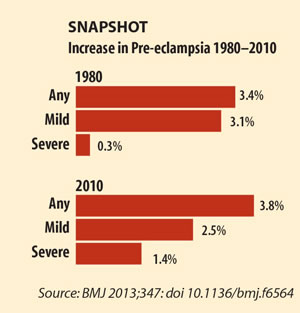Severe Pre-eclampsia on the Rise
Rates of pre-eclampsia have steadily climbed in the U.S. from 1980–2010, driven by a very sharp rise of 322% in the rates of severe pre-eclampsia, according to a new study. Characterized by elevated blood pressure and excess protein in the urine of pregnant women, pre-eclampsia causes complications in approximately 3–6% of all pregnancies.
Researchers examined data on 120 million births in the U.S. from national hospital discharge surveys, making it the largest cohort study to analyze changes in rates of pre-eclampsia in this country. During the study period, pre-eclampsia rates rose from 3.4% in 1980 to 3.8% in 2010. This increase was due to the rise in rates of severe pre-eclampsia—from 0.3% in 1980 to 1.4% in 2010. At the same time, rates of mild pre-eclampsia declined, from 3.1% in 1980 to 2.5% in 2010.

The report predicts that 2014's growth in national health spending will jump to 6.1% as the ACA's major provisions go into effect. Notably, without these reforms projected growth would only rise to 4.5%. The use of medical services and goods—especially prescription drugs and physician and clinical services—among the newly insured is also expected to contribute to significant 12.2% and 7.7% spending increases in Medicaid and private health insurance, respectively.
Projections estimate that by 2022 the ACA will reduce the number of uninsured people by 30 million, which is one major factor predicted to maintain national health spending near 6% over the next several years. After the one-time effects of coverage expansion start to subside in 2016, an acceleration in economic recovery is expected to keep health spending growth buoyed. The report tempers this optimistic outlook, though, by noting that the increased growth will still be slower than the 6.9% growth rate experienced before the recession hit.